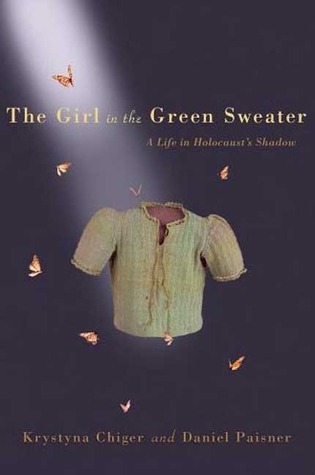
The Girl in the Green Sweater: A Life in Holocaust’s Shadow
Sunday to Thursday: 09:00-17:00
Fridays and Holiday eves: 09:00-14:00
Yad Vashem is closed on Saturdays and all Jewish Holidays.
Entrance to the Holocaust History Museum is not permitted for children under the age of 10. Babies in strollers or carriers will not be permitted to enter.

The Girl in the Green Sweater: A Life in Holocaust’s Shadow
The Girl in the Green Sweater: A Life in Holocaust’s Shadow
By Krystyna Chiger with Daniel Paisner
St. Martin’s Press, 2008
272 pages
In this book, Krystyna Chiger recounts the story of her survival as a child as her family went from their beautiful wealthy home to the Lvov Ghetto and then into the sewers to live out the final fourteen months of the Holocaust.
Krystyna was nearly 4 years old when Germany and Russia divided Poland down the middle in 1939. Living under Communist rule was not easy for Jews in Eastern Poland and even as a small child Krystyna remembers the changes that her family went through when Ukrainians harassed and humiliated Jews on the street, and new policies forced her grandparents out of business.
Once the German army invaded, the situation changed once again for Jews. Krystyna remembers the precious items that were stolen from her family such as their piano, puppy, and artwork. But the positive attitude of a child comes through in her writing, as she recalls when her baby brother was born, and how happy she was to simply be with her family, even in difficult circumstances.
Krystyna’s father, Ignacy Chiger, was a trained carpenter, and used his skills to build clever hiding places for his children while they were in the ghetto. Krystyna would stand or sit with her brother all day sometimes, when their parents went to work, so as not to be discovered by the Nazis. In anticipation of the final liquidation of the Lvov ghetto, Ignacy joined up with two other men and began digging into the sewer lines so that they would be able to escape. With the help of a Polish Catholic man named Leopold Socha, the Chiger family survived fourteen months underground in dark, foul-smelling, rat-infested, sewers, among a group of ten Jews who also sought sanctuary and were provided the same help through Ignacy’s connection with Socha. Krystyna recalls her time in the sewer in great detail. She and her brother tried to make the best of the situation, but there was death and fear surrounding them constantly. Even in the darkest despair, Krystyna shares her thoughts as a little girl and keeps the reader intrigued by the story and the sheer miracle of survival.
Though this book is written through the eyes of a child, the content is difficult and detailed, and is not, in its entirety, appropriate for every student. A teacher should read the book before presenting it to the class, and consider if his/her students can handle this material.

Thank you for registering to receive information from Yad Vashem.
You will receive periodic updates regarding recent events, publications and new initiatives.

"The work of Yad Vashem is critical and necessary to remind the world of the consequences of hate"
Paul Daly
#GivingTuesday
Donate to Educate Against Hate


Worldwide antisemitism is on the rise.
At Yad Vashem, we strive to make the world a better place by combating antisemitism through teacher training, international lectures and workshops and online courses.
We need you to partner with us in this vital mission to #EducateAgainstHate
The good news:
The Yad Vashem website had recently undergone a major upgrade!
The less good news:
The page you are looking for has apparently been moved.
We are therefore redirecting you to what we hope will be a useful landing page.
For any questions/clarifications/problems, please contact: webmaster@yadvashem.org.il
Press the X button to continue



